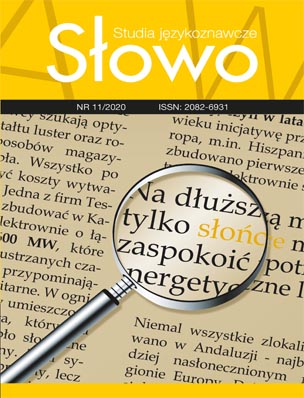Imiennictwo łemkowskie w XIX wieku
DOI:
https://doi.org/10.15584/slowo.2020.11.9Słowa kluczowe:
name, anthroponomastics, LemkoAbstrakt
The name resource of Lemkos living in the first half of the nineteenth century is mostly made up of anthroponyms derived from the Christian tradition, i.e. biblical names, as well as names of the holy martyrs and the blessed of different periods of Christianity, belonging more often to Eastern Churches, a little less often to the Catholic Church. Most of the Lemko anthroponyms derive from the Orthodox-Russian tradition, which in turn has its roots in the Greek tradition. Names of Greek etymology account for 50.5% of the excerpted material. The most common ones include the following: Anastasia, Gregor, Basilius, Andreas, Stephanus, Theodorus, Ksenia, Parasceve, Pelagia, Demetrius, Petrus, Helena. Latin names are much less common (19%), e.g. Paulus, Romanus, Antonius, Ignatius, Julia, Julianus, as well as Hebrew names (12,4%), e,g. Maria, Anna, Ewa, Joannes, Symeon. Germanic names (Wilhelmus, Adalbertus, Conradus, Leopoldus) and Slavic names (Stanislaus) were among the rarest. The analyzed anthroponomastics is characterized by high repeatability of names. The proper names in the top ten make up 57.3% of all units. The most frequently repeated names are Maria, Joannes, Anna, Anastasia, Gregorius, Andreas, Theodorus, Stephanus, Simeon. Names which have appeared once represent only 2.3% of the analyzed anthroponomastics.Downloads
Bibliografia
Barwiński M., 1999, Współczesna tożsamość etniczna i kulturowa Łemków na obszarze Łemkowszczyzny – uwarunkowania i konsekwencje, „Acta Universitatis Lodziensis. Folia Geographica Socio-Oeconomica” 2, Łódź, s. 53–69.
Barwiński M., 2012, Łemkowszczyzna jako region etniczno-historyczny [w:] Region i regionalizm w socjologii i politologii, red. A. Pawłowska, Z. Rykiel, Rzeszów, s. 136–151.
Bata A., 2014, Jaśliska. Dzieje miasteczka i okolic, Krosno.
Grzesik W., Traczyk T., 1992, Od Komańczy do Bartnego: Beskid Niski przewodnik krajoznawczy, Warszawa.
Kopertowska D., 1994, Ewolucja motywacji w imiennictwie, „Język Polski” LXXIV, z. 1, s. 22–33.
Malec M., 1998, Imiona [w:] Polskie nazwy własne. Encyklopedia, red. E. Rzetelska-Feleszko, Kraków, s. 87–118.
Malec M., 2001, Imię w polskiej antroponimii i kulturze, Kraków.
Malec M., 2004, Nazwy własne indywidualnych osób [w:] Nazwy własne w języku, kulturze i komunikacji społecznej, red. R. Mrózek, Katowice, s. 49–63.
Maliszewska A., 1993, Nazwy osobowe ludności łemkowskiej (na podstawie materiałów z nagrobków), „Onomastica” XXXVIII, s. 169–201.
Milewski T., 1969, Imiona osobowe jako zwierciadło kultury [w:] Indoeuropejskie imiona osobowe, T. Milewski, Wrocław, s. 147–154.
Orzechowski K., 1872, Przewodnik statystyczno topograficzny i skorowidz obejmujący wszystkie miejscowości z przysiółkami w Królestwie Galicyi W.X. Krakowskiem i X. Bukowinie, według najświeższych skazówek urzędowych, Kraków.
Reinfuss R., 1990, Śladami Łemków, Warszawa.
Rieger J., 1995, Słownictwo i nazewnictwo łemkowskie, Warszawa.
Rudnicka-Fira E., 2018, Imiona chrzestne w aspekcie wyznaniowo-kulturowym i socjologiczno-historycznym, „Onomastica” LXII, s. 129–144.
Słownik imion, oprac. W. Janowska, A. Skarbek, B. Zbijowska, J. Zbiniowska, Wrocław–Warszawa–Kraków–Gdańsk 1975.
Wolnicz-Pawłowska E., 1993, Antroponimia łemkowska na tle polskim i słowackim XVI–XIX wiek, Warszawa.
Wolnicz-Pawłowska E., 1996, Łemkowskie imiona kobiece, „Studia z Filologii Polskiej i Słowiańskiej”, 33, s. 266–295.
Pobrania
Opublikowane
Jak cytować
Numer
Dział
Licencja
Prawa autorskie (c) 2020 Słowo. Studia językoznawcze

Utwór dostępny jest na licencji Creative Commons Uznanie autorstwa – Użycie niekomercyjne 4.0 Międzynarodowe.


